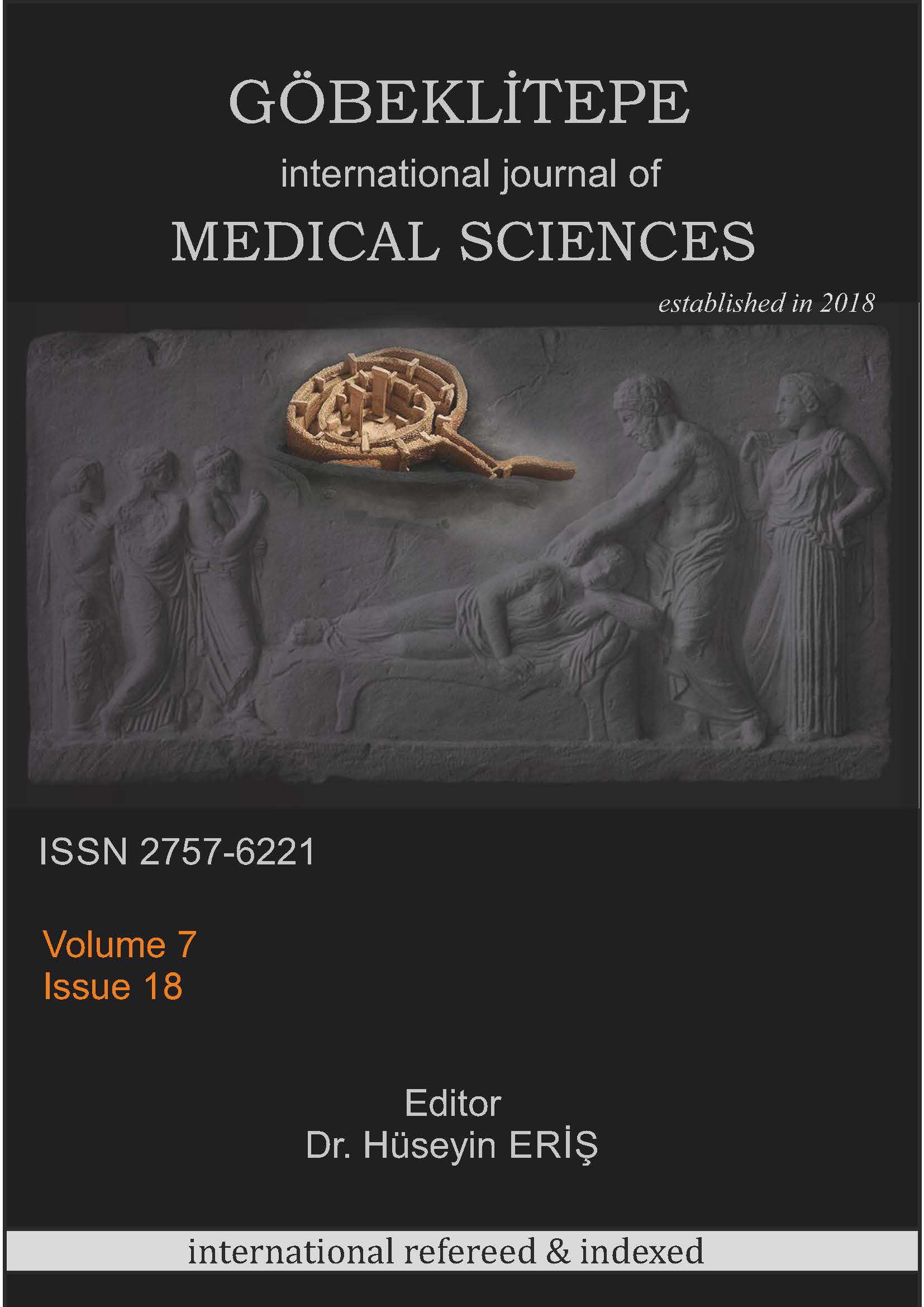HEMŞİRELİK VE EBELİK ÖĞRENCİLERİNDE AĞRI KORKUSU: KESİTSEL BİR ÇALIŞMA
Hemşirelik ve Ebelik Öğrencilerinde Ağrı Korkusu
Anahtar Kelimeler:
Ağrı, Korku, Kaygı, ÖğrencilerÖzet
Bu çalışma sağlık bilimleri fakültesinde öğrenim gören ebelik ve hemşirelik bölümü öğrencilerinin ağrı korkularını belirlemek amacıyla yapılmıştır. Kesitsel tipteki araştırmanın evrenini bir devlet üniversitesinin sağlık bilimleri fakültesinde 2020-2021 eğitim öğretim yılı içerisinde aktif eğitimine devam eden 1430 öğrenci oluşturmuştur. Güç analizi ile örneklem büyüklüğü 633 olarak hesaplanmış ve örneklem seçiminde tabakalı örneklem yöntemi kullanılmıştır. Araştırma verileri Kasım 2020-Şubat 2021 tarihleri arasında toplanmış, veri toplama aracı olarak “Kişisel Bilgi Formu” ve “Ağrı Korkusu Ölçeği-III” formları kullanılmıştır. Veriler SPSS 23.0 istatistik paket programında değerlendirilmiştir. Verilerin analizinde yüzde, frekans, ortalama, standart sapma, bağımsız gruplarda t-testi ve korelasyon testleri kullanılmıştır. Katılımcıların yaş ortalamaları 20.7±1.54’dır ve %73,9 hemşirelik, %26,1 ebelik bölümündendir. Öğrencilerin ölçek alt boyutları toplam puan ortalamaları; şiddetli ağrı korkusu 31,46±8,25, hafif ağrı korkusu 23,89±6,68, tıbbi ağrı korkusu 26,18±7,69 ve ölçek toplam puan ortalamaları 81,52±20,03 olarak bulunmuştur. Yaş ile toplam puan arasında negatif yönde yüksek ilişki, hafif ağrı korkusu ile negatif yönde zayıf ilişki bulunmuştur. Cinsiyet ile bütün alt boyutlar ve toplam puan arasında negatif yönde zayıf ilişki bulunmuştur (p<0.05). Öğrencilerin ağrı korkusu düzeylerinin orta seviyede olduğu, cinsiyetle ve yaşla arasında negatif yönde bir ilişki olduğu belirlenmiştir. Ağrı korkusunun azaltılması için ağrıya yönelik eğitimlerin kapsamlı gruplarda verilmesi önerilmektedir.
Referanslar
Farrell M. (2017). Pain Manangement. Farrell M. (Ed.), Smeltzer & Bare’s Textbook of Medical-Surgical Nursing (Cilt.1-2) içinde (s. 202-229), Philadelphia: Wolters Kluwer.
Drew D. (2018). Pain Manangement. Hinkle JL, Cheever KH (Eds.), Brunner & Suddarth’s Textbook of Medical-Surgical Nursing (14.bs) içinde (s. 224-250), Philadelphia: Wolters Kluwer.
Kılıçarslan F. (2019). Hemşirelik Öğrencilerinin Ağrı İnançları Ve Ağrı Korkuları Arasındaki İlişkinin İncelenmesi. (Yüksek Lisans Tezi). Ankara Yıldırım Beyazıt Üniversitesi Akademik Arşiv Sistemi. Yıldırım Beyazıt Üniversitesi, Ankara.
Vambheim SM, Qien RA. (2017). Sex differences in fear of pain: item-level analysis of the Fear of Pain Questionnaire III. Journal of Pain Research,10, 825–831.
Türk Dil Kurumu. https://sozluk.gov.tr/
Ünver S, Turan FN. (2018). Ağrı Korkusu Ölçeği-III’ün Türkçe geçerlik ve güvenirlik çalışması. Agri, 30(1):18-27. doi: 10.5505/agri.2017.62681.
McNeil DW, Rainwater AJ. (1998). Development of the Fear of Pain Questionnaire—III. Journal of Behavioral Medicine, Vol. 21, No. 4.
Archer KR, Seebach CL, Mathis SL, Riley LH, Wegener ST. (2014). Early postoperative fear of movement predicts pain, disability, and physical health six months after spinal surgery for degenerative conditions. The Spine Journal, 14, 759–767. https://doi.org/10.1016/j.spinee.2013.06.087 .
Mete Z, Avcı Işık S. (2020). Total Diz Protezi Ameliyatı Planlanan Hastaların Cerrahi Korku Düzeyleri ile Ameliyat Sonrası Ağrı Düzeyleri Arasındaki İlişkinin Belirlenmesi. Türkiye Klinikleri J Nurs Sci. 2020;12(3):337-47. doi: 10.5336/nurses.2019-73129.
Tan Çelik F, Köçkar Ç. (2019). Bel Fıtığı Ameliyatı Olan Hastalarda Ağrı ve Korku-Kaçınma Davranışları. Sdü Sağlık Bilimleri Enstitüsü Dergisi, 10(1);18-22.
Ay ZY, Çağlar F, Orun B, Uskun E.(2014). Hastaların ağız sağlığı, dental anksiyete düzeyleri ve olası belirleyicileri ile ilgili bildirimlerinin ölçek sonuçlarıyla tutarlılığı. SDÜ Sağ Bil Der,5(2):56–61.
Oğuzalp H, Pamuk AG, Öcal T. (2010). Günübirlik Cerrahide Ebeveyn Anksiyetesinin ve Beklentilerinin Değerlendirilmesi. Türk Anest Rean Der Dergisi, 38(3):208-216.
Zale EL, Lange KL, Fields SA, Ditre JW. (2013). The relation between pain-related fear and disability: A meta-analysis. J Pain, 14(10): 1019–1030. doi:10.1016/j.jpain.2013.05.005.
Ay F, Alpar ŞE. (2010). Postoperatif ağrı ve hemşirelik uygulamaları. Ağrı, 22(1):21–9.
Keefe FJ, Rumble ME, Scipio CD, Giordano LA, Perri LM. (2004). Psychological aspects of persistent pain: current state of the science. J Pain, 5(4):195–211.
Yang Z.(2020). Identifying pain perceptual biases related to fear of pain and threat in a pain-free sample. Eur J Pain, 24:1084–1093. doi: 10.1002/ejp.1553.
Eren A. (2005). Korku kültürü, değer kültürü ve şiddet. Aile ve Toplu, 2 (9). ISSN: 1303-0256.
Bilsel BA, Durusoy E. Mutuş R. (2023). Ağrı ve Bellek. IGUSABDER, 19: 290-301.
George ZX, Hirsh AT. (2009). Psychologic influence on experimental pain sensitivity and clinical pain intensity for patients with shoulder pain. The Journal of Pain, 10(3): 293-299.
Yılmaz Eker P, Köksel P. (2023). Septorinoplasti olacak hastalara verilen eğitimin cerrahi anksiyete, ağrı korkusu, ağrı ve konfor düzeyi üzerine etkisinin incelenmesi: Randomize kontrollü çalışma. GÜSBD, 12(4): 1711 – 1721.
Turk DC, Robinson JP, Burwinkle T. (2004). Prevalence of foer of pain and activity in patients with fibromyalgia syndrome. The Journal of Pain, 5(9): 483-490.
Dığın F, Mercan Y, Kiyat İ. (2023). Hemşirelik ve ebelik öğrencilerinin ağrı korkusu ve etkileyen faktörler. BANÜ Sağlık Bilimleri ve Araştırmaları Dergisi, 5(3): 222-229. doi: 10.46413/boneyusbad.1279159.
Yıldız R, Yıldız Kızkın Z. (2023). Üniversite öğrencilerinin ağrı korkusu ve ağrıya bağlı engellilik durumlarının araştırılması. JOHESAM, 3: 54-58. ISSN:2757-6914. DOI: 10.29228/JOHESAM.25.
Tiryaki S, Göktaş S. (2022). Diz Artroskopisi Uygulanacak Hastalarda Ağrı Korkusunun Ağrı Şiddetine Etkisinin Değerlendirilmesi: Tanımlayıcı Araştırma. Turkiye Klinikleri J Nurs Sci,14(2):288-95. doi: 10.5336/nurses.2021-83726.
Thibodue MA, Welch PG, Katz J, AsmundsonGJG. (2013). Pain-related anxiety influences pain perception differently in men and women: A quantitative sensory test across thermal pain modalities. Pain, 154: 419-426.
Tan Çelik F, Köçkar Ç. (2019). Bel Fıtığı Ameliyatı Olan Hastalarda Ağrı ve Korku-Kaçınma Davranışları. SDÜ Sağlık Bilimleri Enstitüsü Dergisi, 10(1): 18-22. doi: 10.22312/sdusbed.455785
Frot M, Feine SJ, Bushnell MC. (2004). Sex differences in pain perception and anxiety. A psychophysical study with topical capsaicin. Pain,108: 230–236. doi:10.1016/j.pain.2003.11.017.
Hirsh AT, George SZ, Bialosky JE, Robinson ME. (2008). Fear of Pain, Pain Catastrophizing, and Acute Pain Perception: Relative Prediction and Timing of Assessment. The Journal of Pain, 9(9): 806-812. doi:10.1016/j.jpain.2008.03.012.
Coşansu G. (2014). Verilerin analizi ve yorumlanması. Erdoğan S, Nahcivan N &Esin MN (Eds). Hemşirelikte araştırma: süreç, uygulama ve kritik (2. baskı, s. 235-280). Nobel Tıp Kitabevi.
İndir
Yayınlanmış
Sürüm
- 2024-12-29 (2)
- 2024-12-28 (1)
Nasıl Atıf Yapılır
Sayı
Bölüm
Lisans
Telif Hakkı (c) 2024 Göbeklitepe Sağlık Bilimleri Dergisi

Bu çalışma Creative Commons Attribution 4.0 International License ile lisanslanmıştır.




